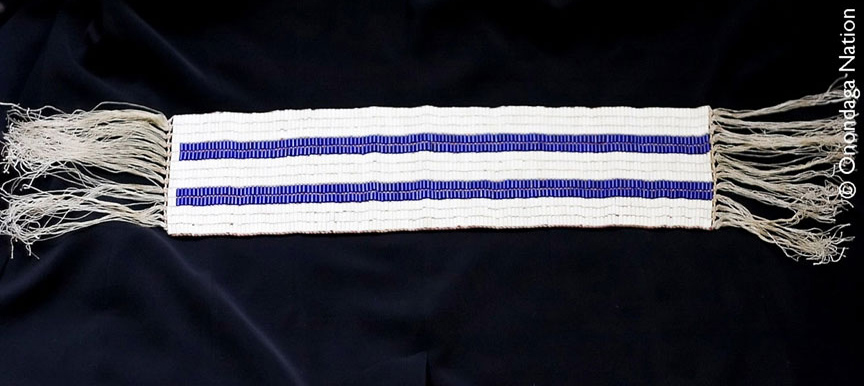In 1613, the Mohawks noticed people coming into their territory unannounced. The visitors had begun to cut trees and clear land for their homes and farms. They had entered the lands of the Haudenosaunee and were now occupying some of their empty rooms (land). The newcomers dressed oddly and had hair on their faces. They had iron pots and pans and had their families with them. These people needed a place to live. The Mohawks sent a runner to Onondaga to convene a meeting of the Haudenosaunee.
At the meeting it was discussed that a delegation must travel to where these people had settled to determine their intentions. It was difficult for the delegation. The people they met spoke in a language they hadn’t heard before. It took much time and patience for the two people to begin to communicate.
After many discussions, it was decided that the Haudenosaunee and the Europeans must have a way to greet each other when they meet. The settlers with their large sailed boat thought that they should be called “Father” and the Haudenosaunee “Son.” The Haudenosaunee said that this would not do. “We shall address each other as ‘Brothers.’ This shows that we are equal to each other.”
As the Haudenosaunee and Dutch discovered much about each other, an agreement was made as to how they were to treat each other and live together. Each of their ways would be shown in the purple rows running the length of a wampum belt. “In one row is a ship with our White Brothers’ ways; in the other a canoe with our ways. Each will travel down the river of life side by side. Neither will attempt to steer the other’s vessel.”
The Haudenosaunee and the Dutch agreed on three principles to make this treaty last. The first was friendship; the Haudenosaunee and their white brothers will live in friendship. The second principle is peace; there will be peace between their two people. The final principle is forever; that this agreement will last forever.
The Dutch recorded this agreement on paper with three silver chains. Iron chains would not do because iron rusts and breaks over time. Silver, on the other hand, can be polished and renewed when the brothers meet. The Haudenosaunee and the Dutch agreed to call this the Silver Covenant Chain of Friendship.
The Haudenosaunee explained to the Dutch that they did not use paper to record their history. They would make belts made of white and purple wampum shells. The Haudenosaunee made a belt to record this agreement. The belt has two purple rows running alongside each other representing two boats. One boat is the canoe with the Haudenosaunee way of life, laws, and people. The other is the Dutch ship with their laws, religion, and people in it. The boats will travel side by side down the river of life. Each nation will respect the ways of each other and will not interfere with the other. “Together we will travel in Friendship and in Peace Forever; as long as the grass is green, as long as the water runs downhill, as long as the sun rises in the East and sets in the West, and as long as our Mother Earth will last.”
Importance of Gaswéñdah Today
The Haudenosaunee see the Two Row Wampum as a living treaty; a way that they have established for their people to live together in peace; that each nation will respect the ways of the other as they meet to discuss solutions to the issues that come before them.

